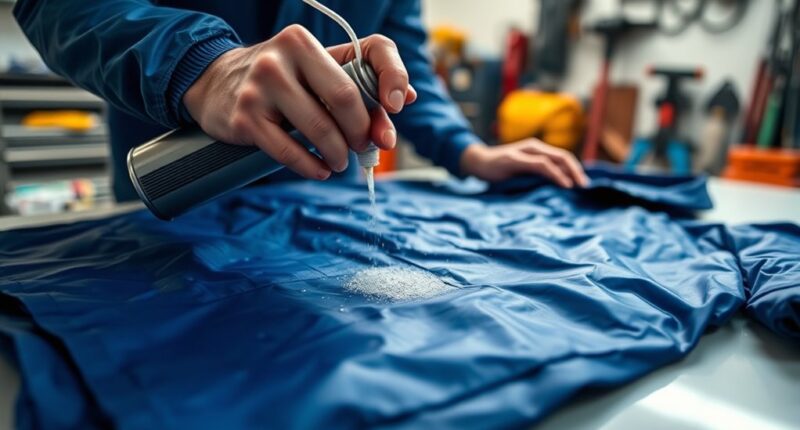To re-waterproof your rain jacket at home, start by cleaning it thoroughly with a gentle detergent, making sure it’s dry before applying any treatment. Next, choose a compatible waterproofing spray or wash-in solution, shaking well before spraying evenly over the entire jacket, focusing on seams and high-wear areas. Allow it to cure for at least 24 hours in a well-ventilated area before testing its water resistance. For detailed steps, keep exploring these helpful tips.
Key Takeaways
- Ensure the jacket is clean, dry, and free of dirt before applying waterproofing products.
- Select a suitable waterproofing spray or wash-in solution compatible with your fabric type.
- Apply the waterproofing evenly in thin coats, focusing on seams and high-wear areas, and let each coat dry thoroughly.
- Allow the jacket to cure in a well-ventilated area for at least 24 hours before exposure to moisture.
- Test water resistance by spraying water on the jacket and reapply waterproofing as needed for optimal protection.
Gathering the Necessary Supplies
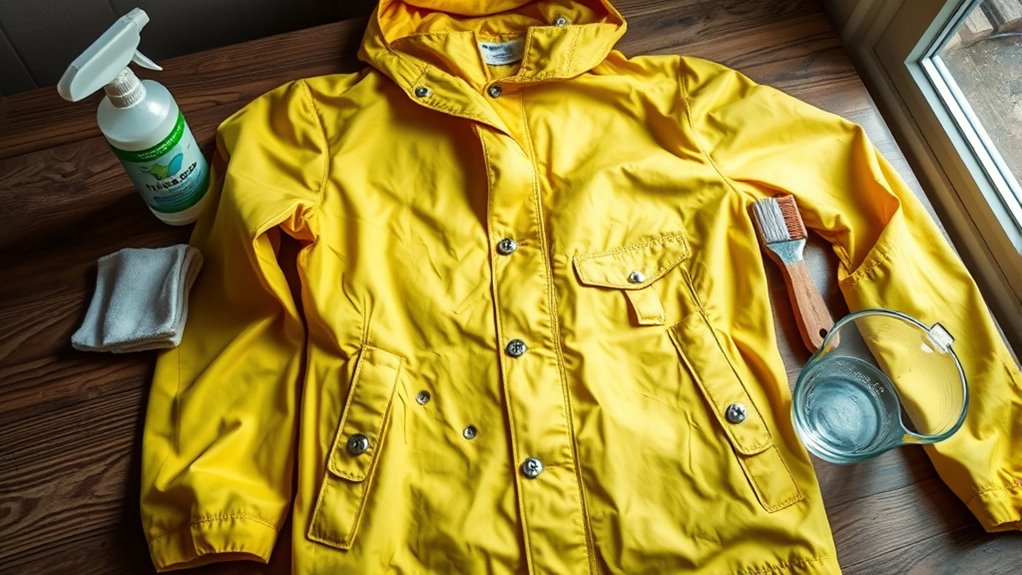
Before you begin re-waterproofing your rain jacket, you need to gather all the necessary supplies. First, identify your jacket’s fabric type—whether it’s nylon, polyester, or Gore-Tex—as this influences the best waterproofing method. Different fabrics respond differently to treatments, so knowing your material helps prevent damage. Next, choose a suitable waterproofing spray designed for your jacket’s fabric type; these sprays are easy to apply and effective at restoring water resistance. You’ll also need a clean, dry workspace, and possibly a hanger to hang the jacket during application. Having these supplies ready guarantees a smooth process. Remember, selecting the right waterproofing spray tailored for your fabric type guarantees better results and prolongs your jacket’s lifespan.
Preparing Your Rain Jacket for Treatment

To guarantee the waterproofing treatment adheres properly, start by thoroughly cleaning your rain jacket. Different fabric types, like nylon, polyester, or Gore-Tex, may require specific cleaning methods or products. Check your jacket’s care label to make sure compatibility. Once clean and dry, inspect the fabric for any damage or worn areas. This step assures the waterproofing spray bonds evenly across the surface. When choosing a waterproofing spray, select one suitable for your jacket’s fabric type. Some sprays work better on synthetic materials, while others are designed for more breathable fabrics. Understanding fabric types and coatings can help you choose the most compatible waterproofing products for your specific jacket. Additionally, knowing how waterproofing treatments work can help you apply them more effectively and extend the life of your rain jacket. Proper application techniques can also influence the durability of the waterproofing layer. For optimal results, consider application methods that ensure even coverage and penetration.
Cleaning and Drying Your Jacket
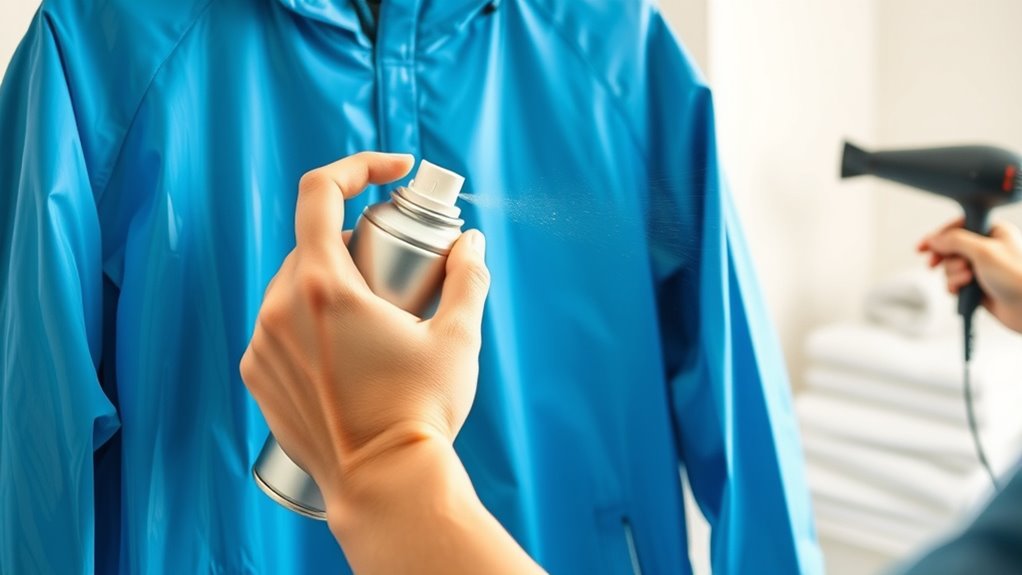
Cleaning and drying your jacket thoroughly is vital to guarantee the waterproofing treatment adheres properly. Start by washing your jacket with a gentle detergent, making sure to remove any detergent residues that can compromise waterproofing. Avoid fabric softeners, as they can leave a coating that reduces the jacket’s breathability and water resistance. Use cold or warm water, and follow the manufacturer’s instructions. Rinse thoroughly to make certain no soap or residues remain. After washing, tumble dry on a low setting or air dry in a well-ventilated area. Proper drying is essential because residual moisture can interfere with the waterproofing process. Understanding Self Watering Plant Pots and their maintenance can help you develop better routines for caring for your outdoor gear and prolong its lifespan. Staying informed about personal debt forgiveness bills can help you understand potential financial options if unexpected expenses arise during your outdoor gear maintenance. Additionally, understanding the role of AI in Business and its impact on customer satisfaction can offer insights into maintaining quality gear and services. Recognizing the importance of diversity in art can also inspire more inclusive approaches to outdoor apparel and gear development. Once your jacket is completely clean and dry, you’re ready to move on to re-waterproofing.
Applying the Waterproofing Solution
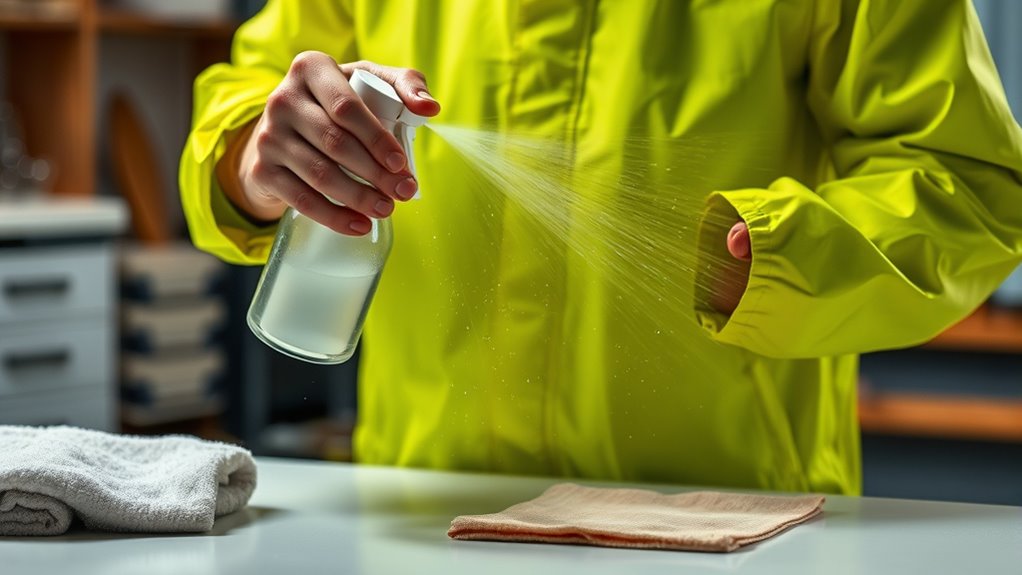
Once your jacket is clean and dry, it’s time to apply the waterproofing solution. To guarantee effective coverage, follow these steps:
- Shake the product well and spray or brush it evenly onto the jacket’s surface, focusing on seams and high-wear areas.
- Keep fabric breathability in mind; avoid over-saturating to prevent clogging pores that allow moisture to escape.
- Always prioritize chemical safety by working in a well-ventilated area and wearing gloves, especially if using sprays or liquids.
- Regular maintenance, such as monitoring for signs of reduced water resistance, helps ensure the jacket maintains its performance and longevity.
- Proper application techniques can also help prevent potential skin irritation, especially for those with sensitive skin.
Applying the solution thoroughly helps restore water resistance without compromising breathability, keeping you dry and comfortable. Remember, even application is key to maintaining the jacket’s performance and longevity.
Ensuring Even Coverage and Proper Application
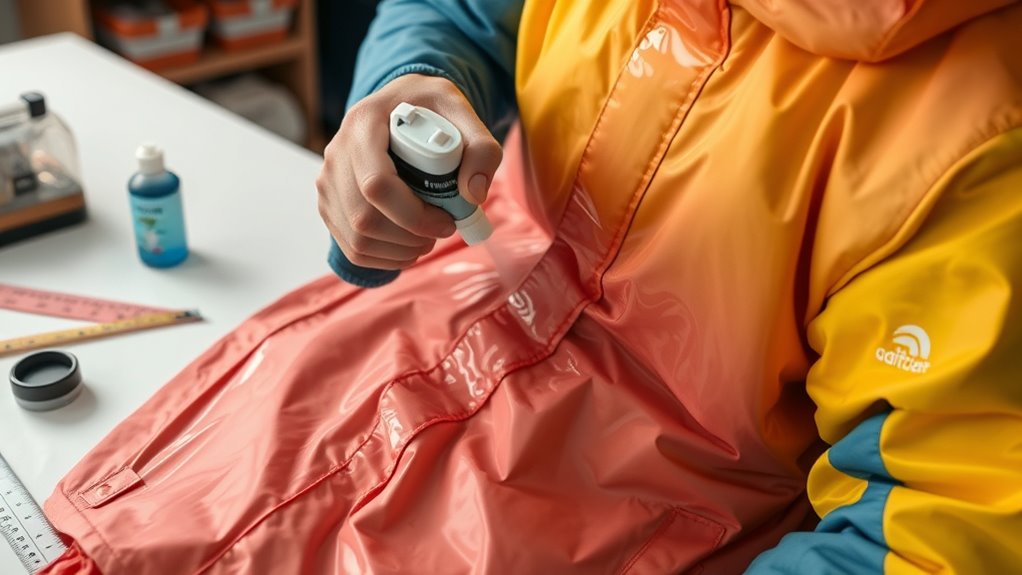
To get the best results, apply the waterproofing solution in thin, even coats. Make certain you cover all areas uniformly, so no spots are missed. Checking your work as you go helps guarantee an even, effective layer.
Apply in Thin, Even Coats
Applying the waterproof spray in thin, even coats is essential to achieve consistent coverage and ideal protection. Different fabric types absorb waterproofing sprays differently, so applying in controlled layers helps guarantee effectiveness. To do this properly:
- Spray in light, sweeping motions to cover all areas without over-saturating.
- Focus on one section at a time, maintaining a steady distance from the fabric.
- Allow each coat to dry completely before applying the next, usually 10-15 minutes.
Using multiple thin coats rather than one thick layer prevents runs and uneven coverage. This technique works with various fabric types, ensuring your jacket remains breathable while staying waterproof. Proper application guarantees the best results from your waterproofing sprays.
Check for Uniform Coverage
Before you finish, it’s important to check that your waterproofing spray has been applied evenly across the entire jacket. Look for uniform coverage, which ensures color consistency and prevents weak spots. Inspect the fabric closely, especially seams and edges, to confirm coverage completeness. An uneven application can cause areas to remain unprotected, risking water penetration. To assess this, hold your jacket in good light and examine it from different angles. If you notice patches with inconsistent sheen or color, reapply spray to those spots. Use the following table as a quick guide:
| Indicator | What to Look For |
|---|---|
| Color consistency | Uniform shine or matte finish |
| Coverage completeness | No patchy or dull areas |
| Overall appearance | Even, smooth application |
This process ensures your jacket is evenly waterproofed and ready for rain.
Allowing the Jacket to Cure and Dry

Once you’ve finished applying the waterproofing spray or treatment, it is vital to give your jacket time to cure and dry properly. This ensures the waterproof layer bonds well and maintains its effectiveness. During the cure time, avoid touching or exposing the jacket to moisture. Follow these key steps to optimize the drying process:
- Hang your jacket in a well-ventilated area away from direct sunlight.
- Allow at least 24 hours for the cure time, or follow the manufacturer’s instructions.
- Check periodically to ensure it’s completely dry and the waterproof coating has set.
Patience during this drying process is essential for achieving a durable, water-repellent finish that lasts. Rushing it can compromise the waterproofing, so give your jacket the time it needs.
Testing and Maintaining Your Re-Waterproofed Rain Jacket

After re-waterproofing your rain jacket, it’s important to test its water resistance and maintain it regularly to guarantee lasting performance. To do this, perform a simple water test by spraying or splashing water on the fabric; if droplets bead and roll off, your jacket is still effective. Keep in mind that re-waterproofing can affect fabric breathability, so monitor for any discomfort or overheating during use. Also, check the jacket fit—over time, wear and cleaning can cause it to loosen or tighten, impacting comfort and protection. Regular maintenance, like cleaning with gentle products and reapplying waterproofing when needed, helps preserve both fabric breathability and jacket fit. This way, you’ll stay dry, comfortable, and protected in future rainstorms.
Frequently Asked Questions
How Often Should I Re-Waterproof My Rain Jacket?
You should re-waterproof your rain jacket whenever it starts to feel less effective, typically after 5-10 wears or if you notice water soaking through. Your care routine and material compatibility are key—check the care label and use suitable waterproofing products. Regular re-waterproofing maintains its performance, so stay attentive to signs of wear, especially in areas prone to abrasion or heavy use.
Can I Use Household Products Instead of Commercial Waterproofing Solutions?
Think of your rain jacket as a shield that needs recharging. While household alternatives and homemade solutions might seem tempting, they often lack the durability of commercial waterproofing products. Using household items like wax or sprays can sometimes work temporarily, but they may not provide long-lasting protection. For best results, stick to trusted waterproofing solutions designed specifically for outdoor gear to keep your jacket reliably waterproof.
Is It Safe to Machine Wash My Jacket After Waterproofing?
You can safely machine wash your jacket after waterproofing, but you should check the fabric care label first. Use a gentle cycle with cold water to prevent damaging the waterproof coatings. Avoid fabric softeners or bleach, as they can strip away the waterproof layer. Proper washing helps maintain the effectiveness of the waterproof coatings, keeping your jacket water-resistant and in good condition for longer.
How Can I Tell if My Jacket Is Fully Waterproof Again?
Think of your jacket as a shield against rain. To see if it’s fully waterproof again, perform a water resistance test—spray water onto the fabric and watch if it beads or soaks in. Check the fabric integrity by inspecting for tears or areas where water might penetrate. If water beads up and no leaks appear, your jacket has regained its waterproof status, just like a sturdy shield ready for the storm.
Will Re-Waterproofing Affect the Jacket’S Breathability?
Re-waterproofing your jacket can slightly affect fabric breathability, but it largely depends on the product you use. Many waterproof layers are designed to maintain breathability while restoring waterproof qualities. If you choose a high-quality treatment, you’ll likely notice minimal impact on fabric breathability. Always follow the instructions carefully, and test your jacket afterward to confirm it stays comfortable and waterproof during your outdoor activities.
Conclusion
Now that you know how to re-waterproof your rain jacket step-by-step, you’re all set to keep dry no matter the weather. With a little effort, you’ll breathe new life into your gear and avoid throwing in the towel too soon. Remember, taking care of your jacket is like tending a garden—consistency pays off. So, roll up your sleeves and get ready to keep the rain where it belongs—outside!
